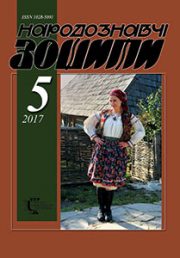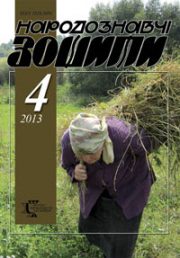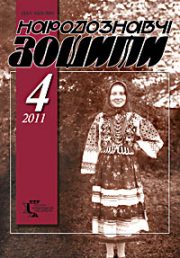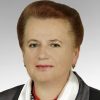The Ethnology Notebooks. 2025. № 5 (185), 1250—1257
UDK398.21:303.4(477.8)
VASYL SOKIL’S FOLKLORISTIC STUDIES: LEGENDS AND HISTORICAL TALES AS AN OBJECT OF RESEARCH
SOKIL Hanna
- ORCID ID: https://orcid.org/0000-0002-8352-2124
- Doctor of Philology, Professor,
- Ivan Franko National University of Lviv,
- 1, Universytetska Street, 79000, Lviv, Ukraine,
- Contacts: e-mail: gan.sokil@gmail.com
Abstract. Vasyl Sokil’s research constitutes a comprehensive contribution to folkloristics. The aim of the article is to highlight his studies on non-fairytale prose and the role in formation of the genre-oriented methodology of Ukrainian scholarship. He was one of the first researchers who approached the problem of studying non-fairytale prose genres systematically, proposed clear criteria of differentiation, developed and substantiated the definitions of «legend», «historical tale», «memorate», «narrative», and presented their genre distinctions according to content, characters, temporal parameters, and the narrator’s epic position. The object of the research is V. Sokil’s scholarly works on non-fairytale prose. The subject is the theoretical issues of genre systematics, in particular the criteria for distinguishing legends and historical tales, the classification of genre variants, and the specificity of mythological motifs in toponymic narratives.
The article reveals the scholar’s role in forming a classification scheme of legends and historical tales based on international systematization and outlines the thematic cycles that were proposed by him. Particular attention is paid to the analysis of folk prose of the Carpathian region, in which the researcher identified archaic mythological elements (belief in giants, metamorphoses, personifications of natural phenomena), as well as plots connected with the rock monuments of Tustan, Bubnyshche, and Rozghirche. The relevance of V. Sokil’s works for contemporary Ukrainian folkloristics is emphasised, since they initiated the systematic study of toponymic prose and became the foundation for further scholarly research. The works of the researcher are still used today in monographs, courses, and methodological materials, although sometimes without proper reference to the author, which calls for more accurate citation and personalization of scholarly achievements. In summary it is concluded that V. Sokil’s studies represent an important contribution to the research of the genre specificity of Ukrainian folk prose, they laid the foundation for compiling a national catalogue of legend and historical tale plots, and remain a significant source for understanding the development of the genre system of Ukrainian folkloristics in general. The article is based on the folklorist’s scholarly research, reviews, responses, and materials from the family archive. The methodology of the research is based on a systemic-historical approach and methods of analytical interpretation and statistical analysis.
Keywords: Vasyl Sokil, legend, historical tale, toponymic prose, mythological motifs, classification, genre systematics.
Received 30.08.2025
REFERENCES
- Sokil, V. (1989). Mythological motifs in toponymic legends of the Ukrainians of the Carpathians. Folk Аrt and Ethnography, 4, 28—33 [in Ukrainian].
- Sokil, V. (1990, May 23—27). Classification of toponymic legends and traditions of the Carpathians. European Symposium «Folklore and the Modern World». Abstracts of reports (Pp. 97—98). Kyiv [in Ukrainian].
- Sokil, V. (1990). Stone epic of the Carpathians. Dzvin, 6, 145—147 [in Ukrainian].
- Sokil, V. (1991, January 24—25). Reflection of the mythologeme of the giant in Carpathian legends. Folklore in the spiritual life of the Ukrainian people: Regional scientific readings (Pp. 83—84). Lviv [in Ukrainian].
- Zamarski, R. (1902). Podania i basni ludu w Mazowszu. Warszawa [in Polish].
- Sokil, V. (1995). Folk legends and legends of Ukrainians of the Carpathians. Kyiv: Naukova dumka [in Ukrainian].
- Davydyuk, V.F. (1992). Ukrainian mythological legend. Lviv [in Ukrainian].
- Brytsyna, O.Yu. (1988). Bylytsia; Buvalshchyna. Ukrainian literary encyclopedia (Vol. 1, pp. 163, 240). Kyiv [in Ukrainian].
- Chornopysky, M.G. (2005). Ukrainian oral folk literature. Prose genres, paremias and drama. Didactic materials and methodological advice for practical classes (P. 32). Lviv [in Ukrainian].
- Ofitsynsky R. (2016). Folk Legends of Zacarpathia. Monograph. Uzhhorod: Hrazhda [in Ukrainian).
- Sokil, V. (1994). Pysana kernytsia. Toponymic Legends and Legends of Ukrainians of the Carpathians. Lviv [in Ukrainian].
- Brytsyna, O. (2000). Prose Genres of Folklore in Recent Publications. Folk Art and Ethnography, 5—6, 129—134 [in Ukrainian].
- Ivashkiv, V. (1993). Review of the Monograph by Vasyl Sokol «Folk Legends and Legends of Ukrainians of the Carpathians». Home Archive of V. Sokil (Pp.1—3) [in Ukrainian].






